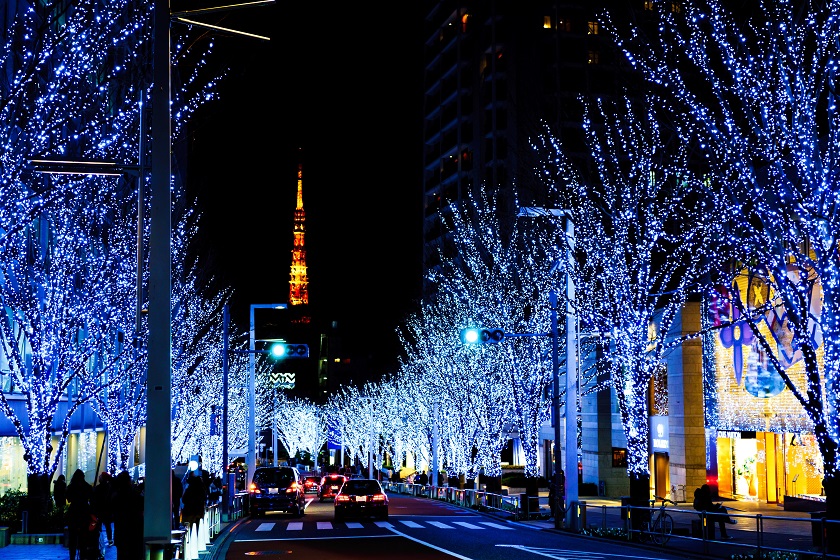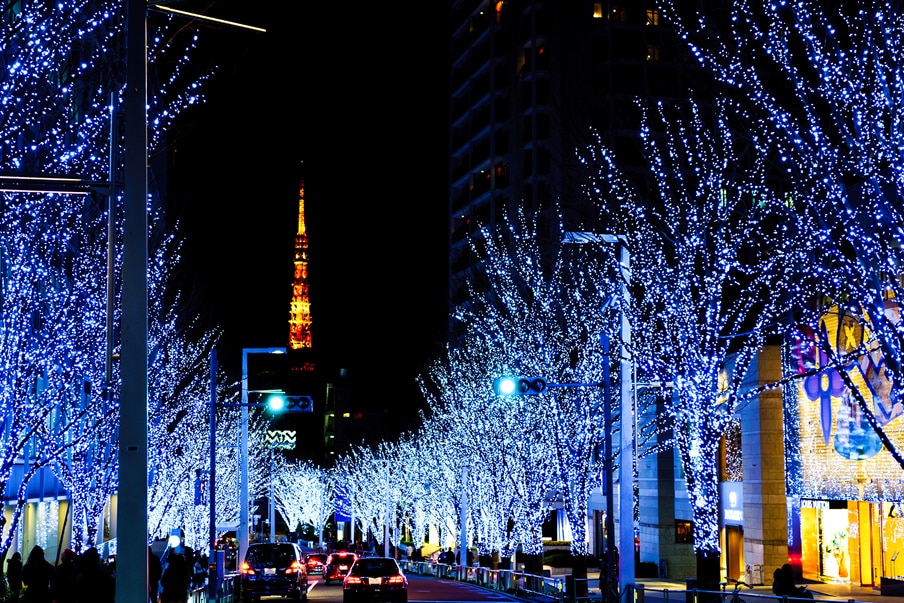The winter in Japan occurs in December, January, and February. Since the weather is cold and snow is common, this is the perfect time to take a ski/snowboard day trip. Most of the mountains are shut down for safety reasons, so during the winter is not a good time to travel to Japan for outdoor-related activities aside from skiing/snowboarding. One other popular attraction during the cold weather is to warm up with a Japanese onsen. While a lot of winter is slow in terms of tourism, from December 29th to January 10th, there are plenty of holiday activities to bring in the new year that often creates difficulty with available flights and hotels, so it is beneficial to book early.

December to February tours
In December to February Winter temperatures average -4°C (25°F) and can reach a low of -25°C (-13°F) in inland areas. Day temperatures generally range between -15 to 5°C (5 to 41ºF) on the lowlands and -20 to 0°C (-4 to 32°F) at higher altitude. Evenings are -25 to -5ºC (-13 to 23ºF).
A winter trip provides unique moments such as snow festivals, winter sports, hot spring baths, and picturesque snow-covered landscapes. The appeal of visiting Japan during the winter includes fewer crowds and the charm of seasonal activities. Cosy up and let us explore Japan’s bucket list winter experiences that you must not miss.
Understanding Winter
Understanding Japan’s winter season is essential before exploring its wintertime activities. From December through February, Japan has colder temperatures with daily highs of 0 °C to 10 °C (32 °F to 50 °F). Despite the cold weather, unique experiences such as snow festivals, skiing, and savoring local cuisine make winter travel in Japan truly special.
During this time, much of the country is covered in a blanket of snow, creating a picturesque winter wonderland. In Japan, winter is a magical season when nature transforms into a breath-taking spectacle. Japan in January offers unique travel conditions with fewer tourists, making popular destinations more accessible and enhancing the tranquility of the experience. It’s a season that invites you to explore and immerse yourself in the beauty to offer with snow-covered mountains, frozen lakes, and frost-covered trees which will leave a lasting impression.
Winter’s Natural Beauty
One of the most attractive aspects of Japan in winter December – February is its natural beauty. The already stunning backdrop is transformed into something out of a fairy tale by the landscapes covered in snow. Each scene, from lit-up cityscapes to peaceful lakes and snow-capped mountains, is a picture-perfect postcard waiting to be taken.
Imagine yourself at the base of Mount Fuji, Japan’s iconic peak, with its magnificent snow-capped summit towering above you. Feel the crisp air filling your lungs, as you take in the expansive perspective of the landscape. The tranquillity of the scene is broken only by the sound of your shoes crunching in the fresh snow.
Talking of nature wonders, in Yamagata Prefecture, the ‘snow monsters‘- trees covered in snow taking on intriguing shapes-create a spectacular landscape that draws visitors for both sightseeing and cultural experiences.
The Tateyama Kurobe Alpine Route in the Japanese Alps with its snow wall is a spectacle you don’t want to miss.
Or, seeking a more immersive experience, you hit the slopes of one of Japan’s world-class ski resorts, providing an array of winter activities. The powdery snow and well-groomed trails of Niseko or Hakuba provide the perfect conditions for an unforgettable winter adventure, with heavy snowfall and scenic landscapes attracting winter sports enthusiasts.
Is snow common in Tokyo in December? Snow is relatively rare in Tokyo in December, with the city typically experiencing its first snowfall in January or February. However, the occasional flurry is not unheard of, so you might just catch a glimpse of snow if you’re lucky!
How to Prepare for Winter Travel in Japan
December – February Winter in Japan is not like the other seasons at all and you need to be well-prepared. When preparing for your winter travel in Japan, it’s essential to pack various items of warm clothing, including thick coats, hats, gloves, and boots. Because temperatures change throughout the day, layering is essential. Also, don’t forget to have a good quality camera with you to capture the beautiful moments you’ll encounter along the way.
Consider visiting natural hot springs to experience the combination of relaxing outdoor baths and stunning natural scenery. These unique and enriching experiences allow you to immerse yourself in mineral-rich waters surrounded by enchanting landscapes.
Your stomach will thank you when you plan ahead to savour Japan’s gastronomic treats as you set off on your winter journey. Winter is the season for hot and comforting dishes such as steaming bowls of ramen, hearty nabe (hot pot), and crispy tempura. In addition to warming you up, these meals provide you a taste of Japanese cuisine.
Frosty Spectacles: The Magic of Snow Festivals
It would be impossible to talk about winter holidays in Japan without mentioning snow festivals, which highlight significant events and traditions during this season. The season’s highlight, these colourful celebrations draw tourists from all over the world. Winter festivals liven up the cold days, and showcase Japan’s creativity, artistry, and cultural heritage.
Sapporo Snow Festival
Japan’s northernmost Hokkaido Island, is a prime destination for winter activities such as skiing and snow festivals. And not just a little, but lots and lots of it. However, staying true to the Japanese spirit, this enormous amount of snow is not something to complain about. Rather, it is to be celebrated, carved and built, and lit up in every possible colour.
Sapporo Snow Festival is the most well-known among Hokkaido’s many winter events. Each year in February, the city comes alive with massive snow sculptures that tower above the streets. These magnificent works of art, meticulously crafted by talented artisans, depict various themes ranging from iconic landmarks to adored characters from Japanese pop culture. Strolling through the festival feels like stepping into a winter wonderland, as the sculptures are beautifully illuminated at night, creating an amazing spectacle.
Aside from the awe-inspiring snow sculptures, the Sapporo Snow Festival provides guests with a wide selection of events and attractions. Both locals and visitors can skate on the ice rink while taking in the enchanting festival atmosphere at ice skating rinks. Food stalls line the streets, serving warm Japanese delicacies such as steamy bowls of ramen, crispy tempura, and sweet treats like freshly baked taiyaki.
Live performances of traditional Japanese music, dance, and theatre are also presented at the festival. Visitors can fully immerse themselves in Japan’s extensive cultural heritage and enjoy the elegance and beauty of traditional arts. The Sapporo Snow Festival offers a look into the heart of Japan, with everything from captivating kabuki dances to taiko drum performances.
Winter Sports in Japan
If you’re a sports enthusiast, a winter trip to Japan offers a wide variety of exciting and unique experiences to get your adrenaline pumping. In fact, Japan is an adventurer’s paradise when it comes to winter sports. With its stunning landscapes and abundant snowfall, this country has become a top destination for skiing, snowboarding, and ice skating.
December is a good time to visit Japan because there are fewer tourists, but the country is full of lights. February is also a good time to visit because the weather is usually sunny and dry, and sightseeing spots are not very crowded. However, the days are relatively short, and the vegetation is barren.
To visit during this month means getting to enjoy many of Japan’s top attractions with fewer tourists around, making December one the best times of year to visit Japan
Conclusion
We have no doubt, Japan in winter is a place that shouldn’t be missed, whether you’re experiencing snow festivals, engaging in winter sports, peeking into the lives of intriguing wild animals, or getting relaxed and romanced in traditional pursuits. A winter trip to Japan offers unique experiences such as hot spring baths, seasonal cuisine, and picturesque snow-covered landscapes. So, pack your warmest clothes and embark on a journey to discover the enchanting beauty of Japan’s winter season.
For those who prefer warmer weather, Japan offers a variety of travel experiences across different seasons, with milder temperatures in months like February compared to the colder winter conditions.
If winter is not your go-to season, then you can opt for spring, autumn or summer – because Japan can be explored all year long.
Table of Contents
Follow us on:
Instagram https://www.instagram.com/abkomrjapaneselanguageschool
Facebook https://www.facebook.com/ABKAots.Thiruvanmiyur
Youtube https://youtube.com/@abkomrjapaneselanguageschool?si=MdM9sTED16WndXS0
Linkedin https://in.linkedin.com/company/abk-aots-dosokai-omr-japanese-languageschool
Check out the previous blogs in this series:
https://abkaots-th.com/unique-importance-of-japanese-language-part-1/
https://abkaots-th.com/top-5-famous-japanese-words
https://abkaots-th.com/how-safety-is-japan-part-1/
https://abkaots-th.com/top-5-important-universities-for-ug-and-pg-courses/
https://abkaots-th.com/advantages-of-other-country-low-birth-rate-in-japan/
https://abkaots-th.com/famous-japanese-food-across-the-world-part-1/
https://abkaots-th.com/unique-favorite-japanese-brands-part-1/
https://abkaots-th.com/jlpt-n5-unique-advantages/


